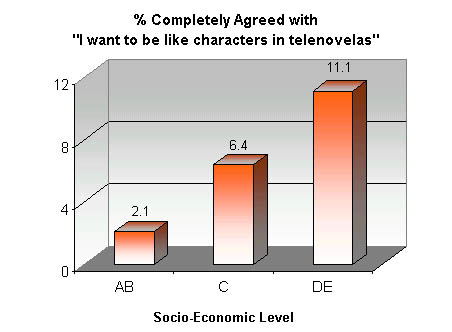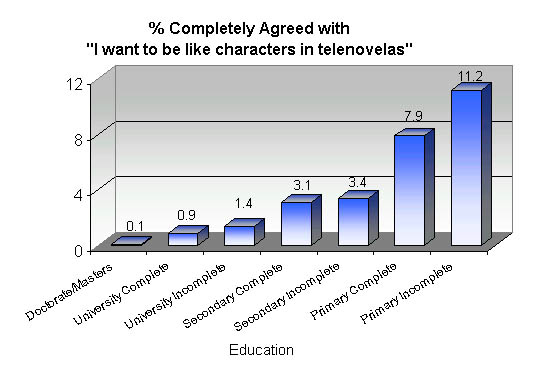
Telenovela Fantasies
What is a telenovela? Ana M. Lopez gave this definition: "It is an essentially melodramatic narrative mode, with roots that can be traced back to prior (Latin American and international) melodramatic forms (in the theater, serial literature, etc.) and their re-inscription and recirculation by the mass media in the cinema and radio ... the telenovela exploits personalization --- the individualization of the social world --- as an epistemology. It ceaselessly offers its audience dramas of recognition and re-cognition by locating social and political issues in personal and familial terms and thus making sense of an increasingly complex world." One of the appeals of telenovelas is that the melodramatic setting allows viewers to live the lives of others vicariously.
We will now cite some data from the TGI Brasil study. This is a survey of 10,624 persons between the ages of 12 and 64 years old in Brazil during 2001. During the survey, the respondents were shown the statement: "I want to be like characters in soap operas." According to the study, 6.6% of the survey respondents 'completely agreed' with that statement.
In the next table, we show the breakdown by age/sex. The agree rates are significantly higher among teenagers (12 to 19 year olds). This result has some significant implications. By and large, human social behavior is not genetically transmitted. Rather, much of it is acquired by learning and imitation. For young people, the growing up process is sometimes painful and anxiety-filled because of vicissitudes and ambiguities of this learning experience. In the absence of mass media, social learning is achieved through human interactions in one's immediate environment. The modern prevalence of mass media, especially television, opens up windows to many different worlds. The data in this table indicate how important telenovelas may be because they provide fictional characters that serve as role models and ideals to young people. This may support the concerns that some people have about the social values that are being transmitted by television programs today.

In the next table, we show the breakdown of the agree rates by socio-economic level. The agree rate is a monotone decreasing function of socio-economic level. The Brazilian author-director Walter Avancini said: "The novela continues to follow the language codes, the tastes, and the ambitions of the middle class, even if class conflict is more manifest in some hourly slots than it was in the past. But the working class continues to be represented in caricature. What is presented as authentic is the values of the bourgeoisie, who tell workers they must learn to live by looking at things they can't pretend to have. I've always said that you can't ask television and the novela to be what they can't. They only reflect the Brazilian situation. Television is not a factor of change. It's only what people want it to be. It's obvious that television bathes in fantasy. It avoids direct confrontation with reality because such a confrontation implies political problems. Workers are not shown on television. At a pinch, they are shown in films or plays where their situation is discussed for an audience which is scarcely interested in changing things in depth. The majority of novela writers in Brazil are also part of an elite, the middle class, and reflect its values."

In the next table, we show the agree rates broken down by the highest level of education attained by the survey respondents. The agree rate is certainly a monotone decreasing function of educational level. On one hand, a well-formed education is presumed to present a real world that is infinitely more interesting and complex than the simplified telenovela world. On the other hand, snobbery must be operating here as educated people are probably unwilling to admit to indulge in fantansies based upon telenovelas.

![]()
ZONA LATINA'S TELENOVELA LINKS
BOOKS
(posted by Roland Soong, 12/18/2001)
(Return to Zona Latina's Home Page)